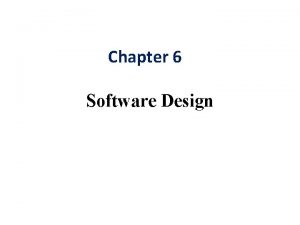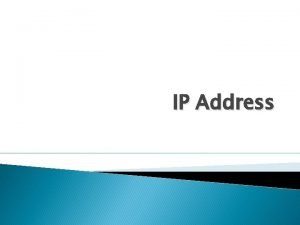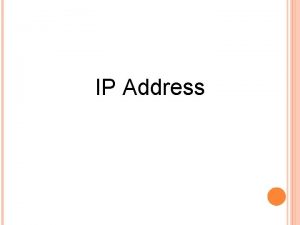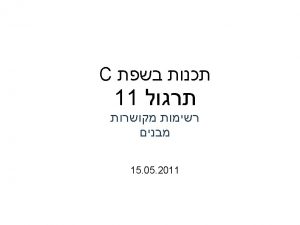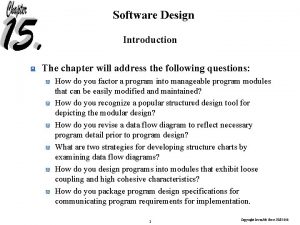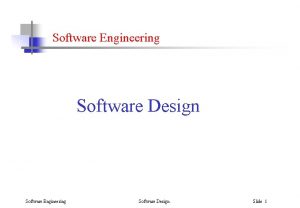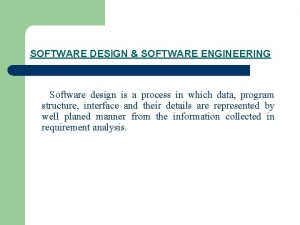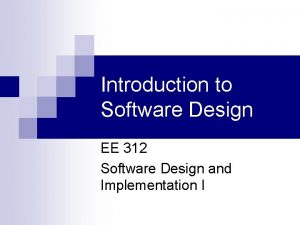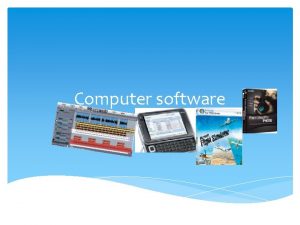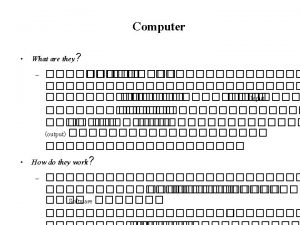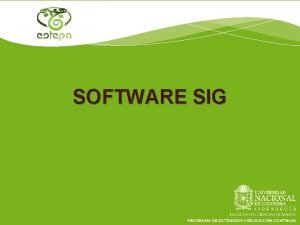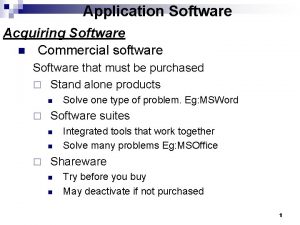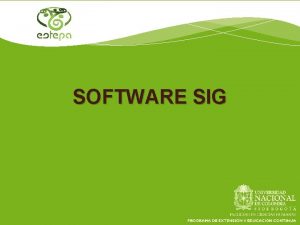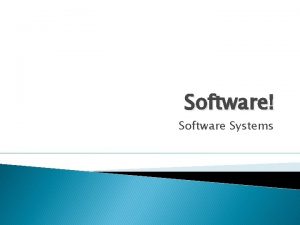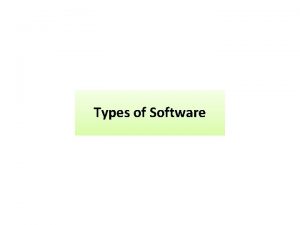Software Design Introduction The chapter will address the





































- Slides: 37

Software Design Introduction : The chapter will address the following questions: < < < How do you factor a program into manageable program modules that can be easily modified and maintained? How do you recognize a popular structured design tool for depicting the modular design? How do you revise a data flow diagram to reflect necessary program detail prior to program design? What are two strategies for developing structure charts by examining data flow diagrams? How do you design programs into modules that exhibit loose coupling and high cohesive characteristics? How do you package program design specifications for communicating program requirements for implementation. 1

Software Design What is Software Design? : Introduction < Software design consists of two components, modular design and packaging. 8 Modular design is the decomposition of a program into modules. 8 A module is a group of executable instructions with a single point of entry and a single point of exit. 8 Packaging is the assembly of data, process, interface, and geography design specifications for each module. 2

Software Design Structured Design : Introduction < Structured design was developed by Ed Yourdon and Larry Constantine. 8 This technique deals with the size and complexity of a program by breaking up a the program into a hierarchy of modules that result in a computer program that is easier to implement and maintain. 3

Software Design 4

Software Design Structured Design : Structure Charts < The primary tool used in structured design is the structure chart. 8 Structure charts are used to graphically depict a modular design of a program. • Specifically, they show the program has been partitioned into smaller more manageable modules, the hierarchy and organization of those modules, and the communication interfaces between modules. • Structure charts, however, do not show the internal procedures performed by the module or the internal data used by the module. 5

Software Design Structured Design : Structure Charts < < < Structure chart modules are depicted by named rectangles. Structure chart modules are presumed to execute in a top-tobottom, left-to-right sequence. An arc shaped arrow located across a line (representing a module call) means that the module makes iterative calls. A diamond symbol located at the bottom of a module means that the module calls one and only one of the other lower modules that are connected to the diamond. Program modules communicate with each other through passing of data. 6

Software Design Structured Design : Structure Charts < < Programs may also communicate with each other through passing of messages or control parameters, called flags. Library modules are depicted on a structure chart as a rectangle containing an vertical line on each side. 7

Software Design 1 2 3 5 6 4 4 6 5 7 8

Software Design Structured Design : Data Flow Diagrams of Programs < < Structured design requires that data flow diagrams (DFDs) first be drawn for the program. Processes appearing on the logical, elementary DFDs may represent modules on a structure chart. Logical DFDs need to be revised to show more detail in order to be used by programmers The following revisions may be necessary: 8 Processes appearing on the DFD should do one function. 8 Processes need to be added to handle data access and maintenance. 8 DFDs must be revised to include editing and error handling processes, and processes to implement internal controls. 9

Software Design 10

Software Design 11

Software Design Structured Design : Transform Analysis < One approach used to derive a program structure chart from program DFD is transform analysis. 8 Transform analysis is an examination of the DFD to divide the processes into those that perform input and editing, those that do processing or data transformation (e. g. , calculations), and those that do output. • The portion consisting of processes that perform input and editing is called the afferent. • The portion consisting of processes that do actual processing or transformations of data is called the central transform. • The portion consisting of processes that do output is called the efferent. 12

Software Design Central Transform Afferent Efferent 13

Software Design Structured Design : Transform Analysis < The strategy for identifying the afferent, central transform, and efferent portions of a begins by first tracing the sequence of processing for each input. 8 There may be several sequences of processing. 8 A sequence of processing for a given input may actually split to follow different paths. 14

Software Design Structured Design : Transform Analysis < Once sequence paths have been identified, each sequence path is examined to identify process along that path that are afferent processes. 8 The steps are as follows: • Step 1 - Beginning with the input data flow, the data flow is traced through the sequence until it reaches a process that does processing (transformation of data) or an output function. • Step 2 - Beginning with an output data flow from a path, the data flow is traced backwards through connected processes until a transformation processes is reached (or a data flow is encountered that first represents output). • Step 3 - All other processes are then considered to be part of the central transform! 15

Software Design 16

Software Design Structured Design : Transform Analysis < Once the DFD has been partitioned, a structure chart can be created that communicates the modular design of the program. 8 Step 1 - Create a process that will serve as a “commander and chief” of all other modules. • This module manages or coordinates the execution of the other program modules. Step 2 - The last process encountered in a path that identifies afferent processes becomes a second-level module on the structure charts. 8 Step 3 - Beneath that module should be a module that corresponds to its preceding process on the DFD. 8 This would continue until all afferent processes in the sequence path are included on the structure chart. 8 17

Software Design 18

Software Design Structured Design : Transform Analysis 8 Step 4 - If there is only one transformation process, it should appear as a single module directly beneath the boss module. • Otherwise, a coordinating module for the transformation processes should be created and located directly above the transformation process. . 8 Step 5 - A module per transformation process on the DFD should be located directly beneath the controller module. 19

Software Design 20

Software Design Structured Design : Transform Analysis Step 6 - The last process encountered in a path that identifies efferent processes becomes a second-level module on the structure chart. 8 Step 7 - Beneath the module (in step 6) should be a module that corresponds to the succeeding process appearing on the sequence path. 8 • Likewise any process immediately following that process would appear as a module beneath it on the structure chart. 21

Software Design 22

Software Design 23

Software Design 24

Software Design Structured Design : Transaction Analysis < An alternative structured design strategy for developing structure charts is called transaction analysis. 8 Transaction analysis is the examination of the DFD to identify processes that represent transaction centers. • A transaction center is a process that does not do actual transformation upon the incoming data (data flow); rather, it serves to route the data to two or more processes. – You can think of a transaction center as a traffic cop that directs traffic flow. – Such processes are usually easy to recognize on a DFD, because they usually appear as a process containing a single incoming data flow to two or more other processes. 25

Software Design 26

Software Design 27

Software Design Structured Design : Transaction Analysis < The primary difference between transaction analysis and transform analysis is that transaction analysis recognizes that modules can be organized around the transaction center rather than a transform center. 28

Software Design Structured Design : Structure Chart Quality Assurance Checks < Coupling: 8 In structured design, the decomposition of a program in manageable modules should be done in such a way that the modules are independent as possible from one another. 8 In structured design programs appearing on a structure chart are evaluated relative to their degree coupling. 8 Coupling refers to the level of dependency that exists between modules. 8 Loosely coupled modules are less likely to be dependent on one another. 29

Software Design Structured Design : Structure Chart Quality Assurance Checks < Coupling: 8 Types of coupling: (from best to worst) • Data coupling — two modules are said to be data coupled if their dependency is based on the fact that they communicate by passing of data. • Stamp coupling — two modules are said to be stamp coupled if their communication of data is in the form of an entire data structure or record. • Control coupling — two modules are said to be control coupled if their dependency is based on the fact that they communicate by passing of control information or flags. • Common coupling — modules are said to be common coupled if they refer to the same global data area. 30

Software Design Structured Design : Structure Chart Quality Assurance Checks < Coupling: 8 Types of coupling: (continued) • Content coupling — two modules are said to be content coupled (also referred to as hybrid coupled) when one module actually modifies the procedural contents of another module. 31

Software Design Structured Design : Structure Chart Quality Assurance Checks < Cohesion: 8 Cohesion refers to the degree to which a module's instructions are functionally related. 8 Highly cohesive modules contain instructions that collectively work together to solve a specific task. 8 The goal is to ensure that modules exhibit a high degree of cohesiveness. 8 Programs that are implemented with highly cohesive modules tend to be easier to understand, modify, and maintain. 32

Software Design Structured Design : Structure Chart Quality Assurance Checks < Cohesion: 8 There are seven types or levels of cohesion and they are as follows: (from most desirable to least desirable) • Functional cohesion — are modules whose instruction are related because they collectively work together to accomplish a single well -define function. • Sequential cohesion — are modules whose instructions are related because the output data from one instruction is used as input data to the next instruction. • Communicational cohesion — are modules whose instructions accomplish tasks that utilize the same piece(s) of data. • Procedural cohesion — are modules whose instructions accomplish different tasks, yet have been combined because there is a specific order in which the tasks are to be completed. 33

Software Design Structured Design : Structure Chart Quality Assurance Checks < Cohesion: 8 There are seven types or levels of cohesion and they are as follows: (continued) • Temporal cohesion — are modules whose instructions appear to have been grouped together into a module because of “time”. • Logical cohesion — are modules that contain instructions that appear to be related because they fall into the same logical class of functions. • Coincidental cohesion — are modules that contain instructions that have little or no relationship to one another. 34

Software Design Packaging Program Specifications : Introduction < As an systems analyst, you are responsible for packaging that set of design documentation into a format suitable for the programmer. 8 This package is called a technical design statement. 8 The technical design statement should include all data, process, interface, and geography building block specifications developed by the designer. 35

Software Design 36

Software Design Summary : : : Introduction What is Software Design? Structured Design 37
 Logical and physical address in os
Logical and physical address in os Real time software design in software engineering
Real time software design in software engineering Design principles in software engineering
Design principles in software engineering Phpipam api
Phpipam api Satori software
Satori software Hình ảnh bộ gõ cơ thể búng tay
Hình ảnh bộ gõ cơ thể búng tay Bổ thể
Bổ thể Tỉ lệ cơ thể trẻ em
Tỉ lệ cơ thể trẻ em Gấu đi như thế nào
Gấu đi như thế nào Tư thế worm breton
Tư thế worm breton Alleluia hat len nguoi oi
Alleluia hat len nguoi oi Các môn thể thao bắt đầu bằng tiếng bóng
Các môn thể thao bắt đầu bằng tiếng bóng Thế nào là hệ số cao nhất
Thế nào là hệ số cao nhất Các châu lục và đại dương trên thế giới
Các châu lục và đại dương trên thế giới Công thức tính thế năng
Công thức tính thế năng Trời xanh đây là của chúng ta thể thơ
Trời xanh đây là của chúng ta thể thơ Cách giải mật thư tọa độ
Cách giải mật thư tọa độ Làm thế nào để 102-1=99
Làm thế nào để 102-1=99 độ dài liên kết
độ dài liên kết Các châu lục và đại dương trên thế giới
Các châu lục và đại dương trên thế giới Thể thơ truyền thống
Thể thơ truyền thống Quá trình desamine hóa có thể tạo ra
Quá trình desamine hóa có thể tạo ra Một số thể thơ truyền thống
Một số thể thơ truyền thống Bàn tay mà dây bẩn
Bàn tay mà dây bẩn Vẽ hình chiếu vuông góc của vật thể sau
Vẽ hình chiếu vuông góc của vật thể sau Thế nào là sự mỏi cơ
Thế nào là sự mỏi cơ đặc điểm cơ thể của người tối cổ
đặc điểm cơ thể của người tối cổ Ví dụ về giọng cùng tên
Ví dụ về giọng cùng tên Vẽ hình chiếu đứng bằng cạnh của vật thể
Vẽ hình chiếu đứng bằng cạnh của vật thể Vẽ hình chiếu vuông góc của vật thể sau
Vẽ hình chiếu vuông góc của vật thể sau Thẻ vin
Thẻ vin đại từ thay thế
đại từ thay thế điện thế nghỉ
điện thế nghỉ Tư thế ngồi viết
Tư thế ngồi viết Diễn thế sinh thái là
Diễn thế sinh thái là Dot
Dot Các số nguyên tố là gì
Các số nguyên tố là gì





































